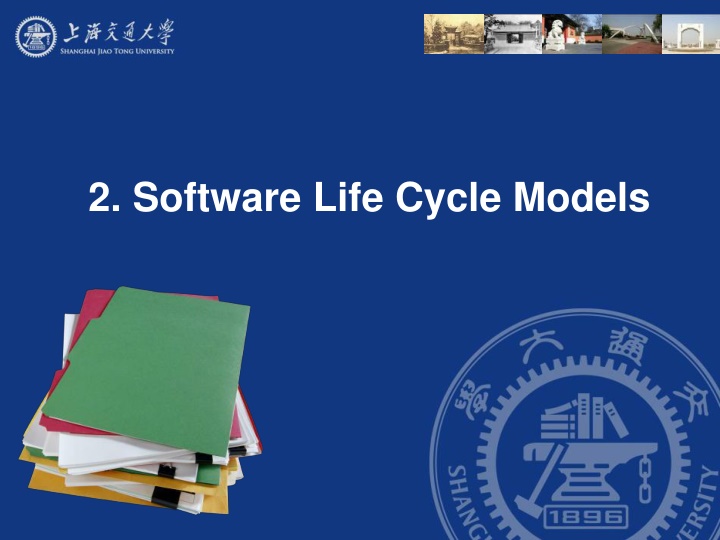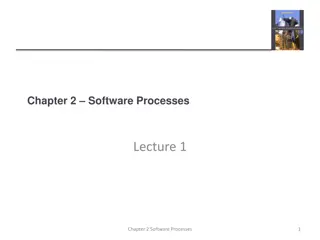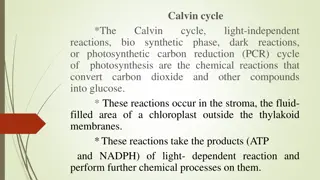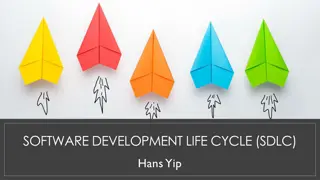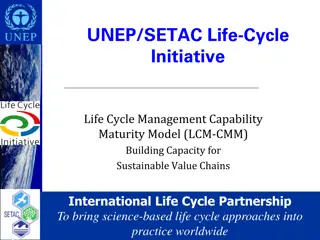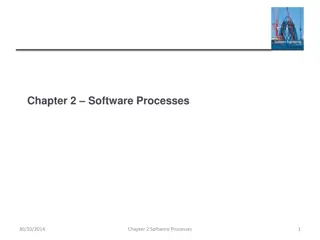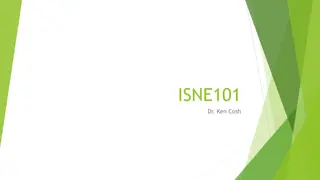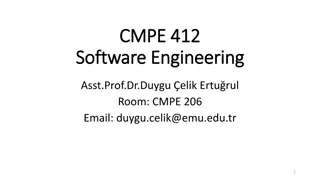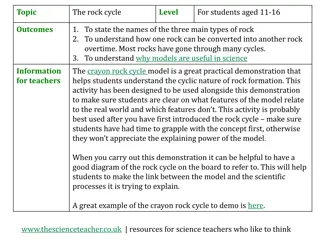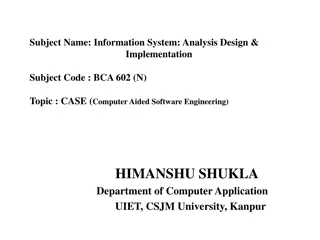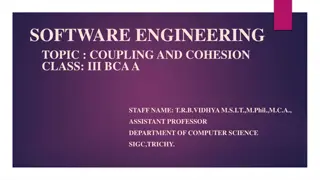Software Development Life Cycle Models Overview
In the realm of software engineering, the development life cycle models play a crucial role in guiding the process of creating software products. This overview delves into various models, including the idealistic approach of software development in theory versus the practical challenges faced in real-world scenarios. From the traditional Waterfall model to the iterative and incremental methods, this exploration sheds light on the evolution and complexities of software development practices. Additionally, concepts like Millers Law and the iterative nature of handling information are discussed to provide insights into managing software projects effectively.
Uploaded on Mar 15, 2025 | 2 Views
Download Presentation

Please find below an Image/Link to download the presentation.
The content on the website is provided AS IS for your information and personal use only. It may not be sold, licensed, or shared on other websites without obtaining consent from the author.If you encounter any issues during the download, it is possible that the publisher has removed the file from their server.
You are allowed to download the files provided on this website for personal or commercial use, subject to the condition that they are used lawfully. All files are the property of their respective owners.
The content on the website is provided AS IS for your information and personal use only. It may not be sold, licensed, or shared on other websites without obtaining consent from the author.
E N D
Presentation Transcript
Overview Software development in theory Iteration and incrementation Risks and other aspects of iteration and incrementation Managing iteration and incrementation Other life-cycle models Comparison of life-cycle models Software Engineering
2.1 Software Development in Theory Ideally, software is developed as described in Chapter 1 Linear Starting from scratch Software Engineering
Software Development in Practice In the real world, software development is totally different We make mistakes The client s requirements change while the software product is being developed Software Engineering
Waterfall Model The linear life cycle model with feedback loops The waterfall model cannot show the order of events Software Engineering
Iteration and Incrementation In real life, we cannot speak about the analysis phase Instead, the operations of the analysis phase are spread out over the life cycle The basic software development process is iterative Each successive version is intended to be closer to its target than its predecessor Software Engineering
Millers Law At any one time, we can concentrate on only approximately seven chunks (units of information) To handle larger amounts of information, use stepwise refinement Concentrate on the aspects that are currently the most important Postpone aspects that are currently less critical Every aspect is eventually handled, but in order of current importance This is an incremental process Software Engineering
Iteration and Incrementation (contd) Figure 2.4 Software Engineering
Iteration and Incrementation (contd) Iteration and incrementation are used in conjunction with one another There is no single requirements phase or design phase Instead, there are multiple instances of each phase Software Engineering
Iteration and Incrementation (contd) The number of increments will vary it does not have to be four Software Engineering
Classical Phases versus Workflows Sequential phases do not exist in the real world Instead, the five core workflows (activities) are performed over the entire life cycle Requirements workflow Analysis workflow Design workflow Implementation workflow Test workflow Software Engineering
Workflows All five core workflows are performed over the entire life cycle However, at most times one workflow predominates Examples: At the beginning of the life cycle The requirements workflow predominates At the end of the life cycle The implementation and test workflows predominate Planning and documentation activities are performed throughout the life cycle Software Engineering
Iteration and Incrementation (contd) Iteration is performed during each incrementation Figure 2.5 Software Engineering
Iteration and Incrementation (contd) Again, the number of iterations will vary it is not always three Software Engineering
More on Incrementation (contd) Each episode corresponds to an increment Not every increment includes every workflow Increment B was not completed Dashed lines denote maintenance Software Engineering
2.7 Risks and Other Aspects of Iter. and Increm. We can consider the project as a whole as a set of mini projects (increments) Each mini project extends the Requirements artifacts Analysis artifacts Design artifacts Implementation artifacts Testing artifacts The final set of artifacts is the complete product Software Engineering
Risks and Other Aspects of Iter. and Increm. (contd) During each mini project we Extend the artifacts (incrementation); Check the artifacts (test workflow); and If necessary, change the relevant artifacts (iteration) Software Engineering
Risks and Other Aspects of Iter. and Increm. (contd) Each iteration can be viewed as a small but complete waterfall life-cycle model During each iteration we select a portion of the software product On that portion we perform the Classical requirements phase Classical analysis phase Classical design phase Classical implementation phase Software Engineering
Strengths of the Iterative-and-Incremental Model There are multiple opportunities for checking that the software product is correct Every iteration incorporates the test workflow Faults can be detected and corrected early The robustness of the architecture can be determined early in the life cycle Architecture the various component modules and how they fit together Robustness the property of being able to handle extensions and changes without falling apart Software Engineering
Strengths of the Iterative-and-Incremental Model (contd) We can mitigate (resolve) risks early Risks are invariably involved in software development and maintenance We have a working version of the software product from the start The client and users can experiment with this version to determine what changes are needed Variation: Deliver partial versions to smooth the introduction of the new product in the client organization Software Engineering
Strengths of the Iterative-and-Incremental Model (contd) There is empirical evidence that the life-cycle model works The CHAOS reports of the Standish Group (see overleaf) show that the percentage of successful products increases Software Engineering
Strengths of the Iterative-and-Incremental Model (contd) CHAOS reports from 1994 to 2006 Software Engineering Figure 2.7
Strengths of the Iterative-and-Incremental Model (contd) Reasons given for the decrease in successful projects in 2004 include: More large projects in 2004 than in 2002 Use of the waterfall model Lack of user involvement Lack of support from senior executives Software Engineering
Managing Iteration and Incrementation The iterative-and-incremental life-cycle model is as regimented as the waterfall model because the iterative-and-incremental life- cycle model is the waterfall model, applied successively Each increment is a waterfall mini project Software Engineering
Other Life-Cycle Models The following life-cycle models are presented and compared: Code-and-fix life-cycle model Waterfall life-cycle model Rapid prototyping life-cycle model Open-source life-cycle model Agile processes Synchronize-and-stabilize life-cycle model Spiral life-cycle model Software Engineering
Code-and-Fix Model No design No specifications Maintenance nightmare Figure 2.8 Software Engineering
Code-and-Fix Model (contd) The easiest way to develop software The most expensive way Software Engineering
Waterfall Model Figure 2.9 Software Engineering
Waterfall Model (contd) Characterized by Feedback loops Documentation-driven Advantages Documentation Maintenance is easier Disadvantages Specification document Joe and Jane Johnson Mark Marberry Software Engineering
Rapid Prototyping Model Linear model Rapid Figure 2.10 Software Engineering
Open-Source Life-Cycle Model Two informal phases First, one individual builds an initial version Made available via the Internet (e.g., SourceForge.net) Then, if there is sufficient interest in the project The initial version is widely downloaded Users become co-developers The product is extended Key point: Individuals generally work voluntarily on an open-source project in their spare time Software Engineering
The Activities of the Second Informal Phase Reporting and correcting defects Corrective maintenance Adding additional functionality Perfective maintenance Porting the program to a new environment Adaptive maintenance The second informal phase consists solely of postdelivery maintenance The word co-developers on the previous slide should rather be co-maintainers Software Engineering
Open-Source Life-Cycle Model (contd) Postdelivery maintenance life-cycle model Figure 2.11 Software Engineering
Open-Source Life-Cycle Model (contd) Closed-source software is maintained and tested by employees Users can submit failure reports but never fault reports (the source code is not available) Open-source software is generally maintained by unpaid volunteers Users are strongly encouraged to submit defect reports, both failure reports and fault reports Software Engineering
Open-Source Life-Cycle Model (contd) Core group Small number of dedicated maintainers with the inclination, the time, and the necessary skills to submit fault reports ( fixes ) They take responsibility for managing the project They have the authority to install fixes Peripheral group Users who choose to submit defect reports from time to time Software Engineering
Open-Source Life-Cycle Model (contd) New versions of closed-source software are typically released roughly once a year After careful testing by the SQA group The core group releases a new version of an open-source product as soon as it is ready Perhaps a month or even a day after the previous version was released The core group performs minimal testing Extensive testing is performed by the members of the peripheral group in the course of utilizing the software Release early and often Software Engineering
Open-Source Life-Cycle Model (contd) An initial working version is produced when using The rapid-prototyping model; The code-and-fix model; and The open-source life-cycle model Then: Rapid-prototyping model The initial version is discarded Code-and-fix model and open-source life-cycle model The initial version becomes the target product Software Engineering
Open-Source Life-Cycle Model (contd) Consequently, in an open-source project, there are generally no specifications and no design How have some open-source projects been so successful without specifications or designs? Software Engineering
Open-Source Life-Cycle Model (contd) Open-source software production has attracted some of the world s finest software experts They can function effectively without specifications or designs However, eventually a point will be reached when the open-source product is no longer maintainable Software Engineering
Open-Source Life-Cycle Model (contd) The open-source life-cycle model is restricted in its applicability It can be extremely successful for infrastructure projects, such as Operating systems (Linux, OpenBSD, Mach, Darwin) Web browsers (Firefox, Netscape) Compilers (gcc) Web servers (Apache) Database management systems (MySQL) Software Engineering
Open-Source Life-Cycle Model (contd) There cannot be open-source development of a software product to be used in just one commercial organization Members of both the core group and the periphery are invariably users of the software being developed The open-source life-cycle model is inapplicable unless the target product is viewed by a wide range of users as useful to them Software Engineering
Open-Source Life-Cycle Model (contd) About half of the open-source projects on the Web have not attracted a team to work on the project Even where work has started, the overwhelming preponderance will never be completed But when the open-source model has worked, it has sometimes been incredibly successful The open-source products previously listed have been utilized on a regular basis by millions of users Software Engineering
Agile Processes Somewhat controversial new approach Stories (features client wants) Estimate duration and cost of each story Select stories for next build Each build is divided into tasks Test cases for a task are drawn up first Pair programming Continuous integration of tasks Software Engineering
Unusual Features of XP The computers are put in the center of a large room lined with cubicles A client representative is always present Software professionals cannot work overtime for 2 successive weeks No specialization Refactoring (design modification) Software Engineering
Acronyms of Extreme Programming YAGNI (you aren t gonna need it) DTSTTCPW (do the simplest thing that could possibly work) A principle of XP is to minimize the number of features There is no need to build a product that does any more than what the client actually needs Software Engineering
Agile Processes XP is one of a number of new paradigms collectively referred to as agile processes Seventeen software developers (later dubbed the Agile Alliance ) met at a Utah ski resort for two days in February 2001 and produced the Manifesto for Agile Software Development The Agile Alliance did not prescribe a specific life-cycle model Instead, they laid out a group of underlying principles Software Engineering
Agile Processes Agile processes are a collection of new paradigms characterized by Less emphasis on analysis and design Earlier implementation (working software is considered more important than documentation) Responsiveness to change Close collaboration with the client Software Engineering
Agile Processes (contd) A principle in the Manifesto is Deliver working software frequently Ideally every 2 or 3 weeks One way of achieving this is to use timeboxing Used for many years as a time-management technique A specific amount of time is set aside for a task Typically 3 weeks for each iteration The team members then do the best job they can during that time Software Engineering
Agile Processes (contd) It gives the client confidence to know that a new version with additional functionality will arrive every 3 weeks The developers know that they will have 3 weeks (but no more) to deliver a new iteration Without client interference of any kind If it is impossible to complete the entire task in the timebox, the work may be reduced ( descoped ) Software Engineering
Agile Processes (contd) Another common feature of agile processes is stand-up meetings Short meetings held at a regular time each day Attendance is required Participants stand in a circle They do not sit around a table To ensure the meeting lasts no more than 15 minutes Software Engineering
